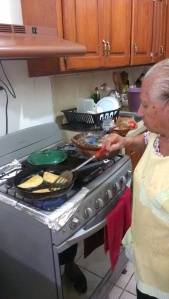 I haven’t been here in a while, I know. I’ve been too busy writing in other blogs and editorial mediums for this little blog of mine. But alas! I am here and I’m ready to tell a couple of stories about diabetes and my travels to Mexico, lindo y querido.
I haven’t been here in a while, I know. I’ve been too busy writing in other blogs and editorial mediums for this little blog of mine. But alas! I am here and I’m ready to tell a couple of stories about diabetes and my travels to Mexico, lindo y querido.
It’s been a few weeks since I’ve been back from Mexico City and Guerrero, two places that I hold very dear to my heart. I’ve written about my travels and how I felt from a cultural standpoint, but I didn’t really discuss the health issues that I saw and that have emerged since I’ve gotten back.
In recent news, a study emerged from the UN stating that over 32 percent of Mexicans are obese and 70 percent are overweight. I can’t say that I didn’t see this. I did. Very much. Because of this weight problem, almost the same that we see here in the United States, we see a sharp increase in Type 2 diabetes diagnosis. The two go hand in hand.
Articles talking about this issue have stated over and over again that it’s due to malnutrition that Mexicans are overweight. Though this may be true in smaller towns and rural areas, where people eat the cheapest option (mostly chips, candy and pop), in Mexico City it’s not so much malnutrition as a sedentary lifestyle where people are sitting more behind desks than they are harvesting their crops in the field.
Experts and journalists can claim a lot of different issues, but the truth is, when you visit Mexico it’s hard to tell the difference between Mexican communities on this side of the border and actual neighborhoods in Mexico City. There are Burger Kings, Starbucks, McDonald’s and KFCs down there now. And since people look to American “restaurants” as a luxury, they start eating it. Granted, the food down there is healthier than what you find up here. Even the fast food.
Though, we have to think about the violence and turbulence in the country as a whole and how that may even be preventing people from being healthy. It must be taken into consideration, especially when the issue of malnutrition and poverty is at hand.

When I was down there for the week, I ate four times a day until I was ready to pop. Each time I ate, I took the exact amount of insulin and four hours later, my blood sugar dropped as it should and it was time to eat again. Oh, the freshness! My tía would go into town in the morning to buy food for breakfast. It was a daily trip to take to make fresh food that would go bad in two days. Can you imagine that?
The difference between here and there is that their naturally grown food is coming from seed that’s not necessarily genetically manufactured and not grown in bulk. Since growing natural food here is a business, how do you know there is any nutrition left in the lettuce, spinach and corn that we’re eating? If Mexicans stuck to natural foods, they would be a lot healthier. Me, I can live on fruit!
The other issue is corn. Maize is the livelihood of Mexicans. You can make anything with corn and it’s almost in every dish. It’s heavy and has carbs and a lot of the time the food made with corn is fried. What do you get? Larger waistlines and bad teeth.
It’s all about balance and what Mexican people are not learning is that balance. There were few people running around the park when I was out there. I would also bet money that violence has a lot to do with the reason why people are staying inside. Farmers are no longer needing to work because they are out of jobs. Why? NAFTA. OK, that’s an easy scapegoat, but in reality, farmers are out of jobs because countries like the United States are selling their corn much cheaper than the cost of living in Mexico. We grow in bulk, have everything manufactured and have capitalized on capitalization.
I sat there and thought about the chain of issues that are caused and how in the end, leads to fatter people and a growing epidemic in a country that doesn’t need it. There are many other political thoughts that go through my head when thinking about these issues, but nonetheless, I need to keep a focus.

A good family friend that we stayed with who is in her 70s was telling me about how she was diagnosed with Type 2 about 15 years ago, maybe more. She explained how she had to go to classes to learn about management and nutrition. Because she was scared to lose limbs and die, she took steady care of herself and didn’t need to be on any medication. Then she found out her daughter was moving out of the house without being married (obviously, a big NO NO) and her emotional distress elevated her blood sugar levels to the point that she had to return to medication.
She’s convinced her diabetes is stress and emotion related. Whatever it is, she’s doing well now. She goes to the doctor and manages herself with oral medication. The fear put her in her place in terms of education and treating herself well. She’s now at a point where she knows her body and knows what she can’t eat and what she can’t. Everything in moderation.
Her daughter was recently diagnosed with Type 2 as well and is at the same point she was: afraid. I said, I’ve been living with it for over 20 years and I’m fine. You just have to know your body. She also told me that her doctor said not to be afraid of insulin. I said, nope! Don’t be! I’ve been on it since I was diagnosed and I can still see! The myth there is that if you start on insulin, you’ll go blind. Every Type 1 knows that’s a lie.
I talked about this last night on DSMA en Vivo in Spanish with Mila Ferrer, my co-host. Listen to it if you speak Spanish. Other than that, I’m done with my rant and I’ll see you all next time I get inspired!

